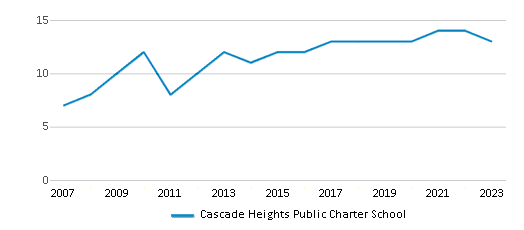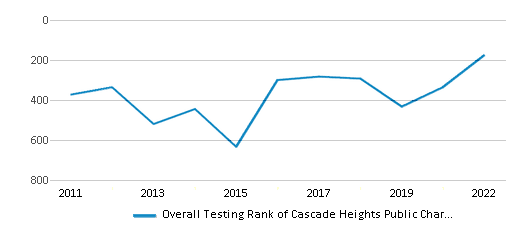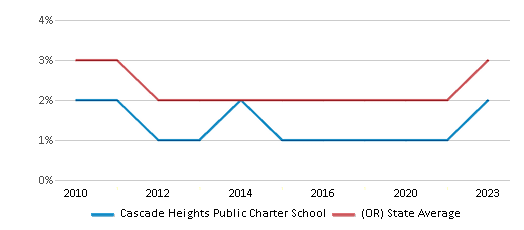Serving 226 students in grades Kindergarten-8, Cascade Heights Public Charter School ranks in the top 20% of all schools in Oregon for overall test scores (math proficiency is top 10%, and reading proficiency is top 10%).
The percentage of students achieving proficiency in math is 55-59% (which is higher than the Oregon state average of 31%). The percentage of students achieving proficiency in reading/language arts is 50-54% (which is higher than the Oregon state average of 44%).
The student:teacher ratio of 17:1 is equal to the Oregon state level of 17:1.
Minority enrollment is 29% of the student body (majority Asian and Hispanic), which is lower than the Oregon state average of 42% (majority Hispanic).
Quick Stats (2025)
- School Type: Charter School
- Grades: Kindergarten-8
- Enrollment: 226 students
- Student:Teacher Ratio: 17:1
- Minority Enrollment: 29%
- Overall Testing Rank: Top 20% in OR
- Math Proficiency: 55-59% (Top 10%)
- Reading Proficiency: 50-54% (Top 30%)
- Science Proficiency: 30-39% (Top 50%)
- Source: National Center for Education Statistics (NCES), OR Dept. of Education
Top Rankings
Cascade Heights Public Charter School ranks among the top 20% of public schools in Oregon for:
Category
Attribute
Overall Rank
Math Proficiency
School Overview
Cascade Heights Public Charter School's student population of 226 students has grown by 6% over five school years.
The teacher population of 13 teachers has stayed relatively flat over five school years.
School Type
Grades Offered
Grades Kindergarten-8
Total Students
226 students

Gender %

Total Classroom Teachers
13 teachers

Students by Grade

School Rankings
Cascade Heights Public Charter School ranks within the top 20% of all 1,196 schools in Oregon (based off of combined math and reading proficiency testing data).
The diversity score of Cascade Heights Public Charter School is 0.48, which is less than the diversity score at state average of 0.60. The school's diversity has stayed relatively flat over five school years.
Overall Testing Rank
#175 out of 1196 schools
(Top 20%)
(Top 20%)

Math Test Scores (% Proficient)
55-59%
31%

Reading/Language Arts Test Scores (% Proficient)
50-54%
44%

Science Test Scores (% Proficient)
30-39%
30%

Student : Teacher Ratio
17:1
17:1

American Indian
n/a
1%

Asian
9%
4%

Hispanic
7%
26%

Black
3%
3%

White
71%
58%

Hawaiian
1%
1%
Two or more races
9%
7%

All Ethnic Groups



Eligible for Free Lunch
24%
51%

Eligible for Reduced Lunch
4%
3%

School Statewide Testing
School District Name
Source: National Center for Education Statistics (NCES), OR Dept. of Education
Profile last updated: 02/09/2025
Frequently Asked Questions
What is Cascade Heights Public Charter School's ranking?
Cascade Heights Public Charter School is ranked #175 out of 1,196 schools, which ranks it among the top 20% of public schools in Oregon.
What percent of students have achieved state testing proficiency in math and reading?
55-59% of students have achieved math proficiency (compared to the 31% OR state average), while 50-54% of students have achieved reading proficiency (compared to the 44% OR state average).
How many students attend Cascade Heights Public Charter School?
226 students attend Cascade Heights Public Charter School.
What is the racial composition of the student body?
71% of Cascade Heights Public Charter School students are White, 9% of students are Asian, 9% of students are Two or more races, 7% of students are Hispanic, 3% of students are Black, and 1% of students are Hawaiian.
What is the student:teacher ratio of Cascade Heights Public Charter School?
Cascade Heights Public Charter School has a student ration of 17:1, which is equal to the Oregon state average of 17:1.
What grades does Cascade Heights Public Charter School offer ?
Cascade Heights Public Charter School offers enrollment in grades Kindergarten-8
What school district is Cascade Heights Public Charter School part of?
Cascade Heights Public Charter School is part of North Clackamas SD 12 School District.
School Reviews
5 2/28/2012
This School is incredible. The teachers are great and truly place the children first. I don't understand why more schools do not have uniforms. It is nice to leave society at home and create an environment where learning comes first. The Administration is easy to talk to and very helpful in any question you may have. There is a good deal of parent involvement at this school also.
2 7/11/2011
We pulled our child from this school before she even attended as they refused to work with us regarding one item on the dress code and how it would aggravate a skin condition our child has. We were told that other people at the school had a similar condition and they just put up with it. No child should have to 'put up with' an aggravated skin condition just to satisfy this school's rigid and outdated dress requirements. If this school is that inflexible over a health condition, it may be safe to assume that they are equally inflexible on other issues as well. I wouldn't recommend this school to anyone.
Review Cascade Heights Public Charter School. Reviews should be a few sentences in length. Please include any comments on:
- Quality of academic programs, teachers, and facilities
- Availability of music, art, sports and other extracurricular activities
Recent Articles

What Is A Charter School?
Explore the world of charter schools in this comprehensive guide. Learn about their history, how they operate, and the pros and cons of this educational innovation. Discover key facts about charter schools, including admission policies, demographics, and funding, as well as what to look for when considering a charter school for your child.

10 Reasons Why High School Sports Benefit Students
Discover the 10 compelling reasons why high school sports are beneficial for students. This comprehensive article explores how athletics enhance academic performance, foster personal growth, and develop crucial life skills. From improved fitness and time management to leadership development and community representation, learn why participating in high school sports can be a game-changer for students' overall success and well-being.

February 05, 2025
Understanding the U.S. Department of Education: Structure, Impact, and EvolutionWe explore how the Department of Education shapes American education, from its cabinet-level leadership to its impact on millions of students, written for general audiences seeking clarity on this vital institution.






